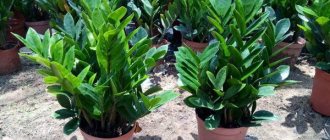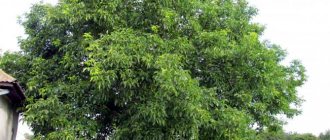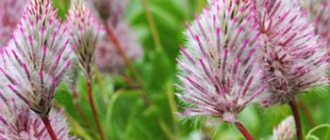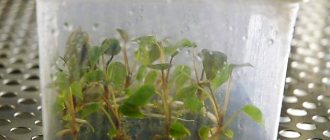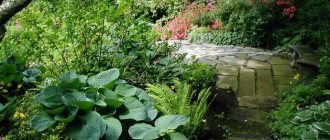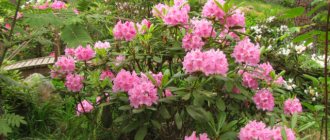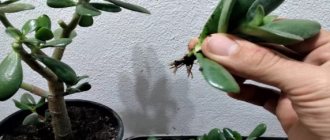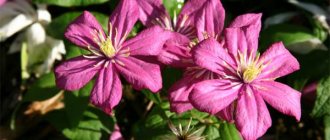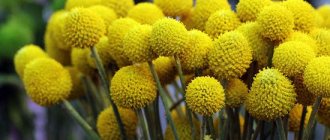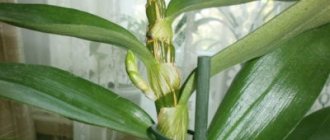The low ornamental shrub synadenium will be a bright addition to a residential or office interior. The low-maintenance plant has long been loved by designers and florists for its original shape and unusual foliage color. Euphorbia bushes (another name for the species) are often included in interesting floral compositions or placed in flowerpots with grown trees around the room as bright, sophisticated accents. In addition to aesthetic pleasure, the plant brings benefits by effectively purifying the air and attracting positive energy into the house.
screenshot_8.jpg
General information
A perennial shrub in indoor conditions does not grow too tall, whereas in its homeland you can find simply gigantic specimens up to 3-3.5 m. Euphorbia is easy to form by cutting off unwanted shoots and pinching the top, thereby stimulating the growth of green mass and the development of lateral branches.
The thick, shortened, massive stem with dense skin is completely covered with the finest hair-glands, due to which the plant stores moisture on favorable days and easily copes with persistent drought. The hard leaves are oval-elongated, lobed (up to 10-12 cm wide, 20-25 cm long) with a smooth shiny surface. The color is rich, emerald green with rare inclusions of pinkish-red stains and spots. There are also subspecies with purple colors.
Synadenium has an exclusively decorative function and is not used in practice at home, but is actively included in all kinds of flower arrangements, where it contrasts effectively against the background of other representatives of indoor flora.
screenshot_1.jpg
Growing a flower and creating optimal conditions
Tropical Synadenium is undemanding and easy to care for. The origin of the succulent and its biological characteristics require compliance with certain rules and regulations for keeping the plant at home.
Watering
The main rule is moderate dosed watering. It is necessary to moisten the soil only when the top layer in the pot dries 5-6 cm. In spring and summer, with strong evaporation, the flower is watered more often than in autumn and winter. In winter, watering is rare - 1-2 times a month in small doses.
The water from the pan is immediately drained after the procedure. Use only purified or settled water at room temperature.
Lighting
In the shade, an African resident feels bad - he loses his decorativeness, his shape, and begins to stretch out. But bright, direct, aggressive rays are also contraindicated for Synadenium. The optimal location is east and west windows.
The windows are covered with blinds or a light curtain from the midday sun. Domestic specimens prefer bright but diffused light.
You can read how to hang blinds on plastic windows here.
In spring and summer, pots are taken out onto the balcony, loggia or veranda. Fresh air promotes hardening and active growth.
Temperature
Optimal conditions are room temperature – 20-23 0 C. In hot weather, the flower normally tolerates temperature increases up to 26-28 0 C.
Feature - exotic does not like sharp temperature fluctuations; in the autumn-winter period, a decrease in temperature to 6-10 0 C is unacceptable.
Humidity
The flower does not require regular spraying. Air humidity - 75-85%. In hot weather, in order to lower the temperature, it is recommended to wipe the leaves with a damp sponge or wash off dust from the leaves with running water.
After the procedure, it is important to wipe the leaves dry. Water should not accumulate in the sinuses. Drops on the surface of the leaf plate leave stains.
In a damp, musty room, putrefactive processes develop.
In winter, the pots are moved deeper into the room, away from fireplaces, heating appliances and radiators.
The soil
The soil for Synadenium should be loose, not very nutritious, and neutral in acidity. You can use ready-made mixtures for succulents.
Prepare the soil mixture yourself (proportions - 1: 1: 1: 1: 13):
- turf;
- peat;
- humus;
- coarse sand;
- charcoal (for disinfection).
A drainage layer is required. Expanded clay, vermiculite, red brick chips, polystyrene foam, etc. are used.
Transfer
The procedure is carried out in early spring, in March. Young flowers are replanted every year, adult specimens - after a year or two.
Advice from experienced flower growers:
- it is better to use the transshipment method, preserving the earthen lump;
- before planting, remove damaged root shoots, wilted leaves, and rotten fragments;
- powder the cut areas with crushed charcoal or activated carbon;
- It is important to disinfect the soil mixture - heat it in the oven or microwave;
- treat tools and planting containers with a disinfecting solution;
- carry out the work with gloves, the milky sap causes an allergic reaction (irritation, itching, burns of the skin and mucous membranes).
During transplantation, pruning is carried out to form a bush and branching - the apical shoots are cut off.
Fertilizer
Synadenium should also be fed in moderate doses. It is important not to overfeed the plant - the stems will begin to crack.
In spring, mineral complexes for cacti or succulents are added:
Attention! The dosage, method and frequency of fertilizing are contained in the instructions for the drug.
Curious facts
Often people simply call a bushy indoor plant “the tree of love.” Why is the flower called this? There are several versions. Most often, this nickname is explained by the unusual shape of the buds - small, bright, blood-red flowers, collected in spreading umbrellas, that look like miniature bells-hearts.
After a short flowering, dense and equally small fruit boxes with dark burgundy seeds ripen. However, it may not be possible to wait for a spectacular spectacle at home. Euphorbia practically does not bloom in captivity; rare cases are recorded in the summer months, but in its natural habitat, in hot African countries, synadenium readily blooms throughout the winter. This applies to all varieties.
Today, the flower family includes up to 20 varieties, but two varieties are most often grown at home: granta, rubra; Let's get to know them better.
screenshot_7.jpg
Synadenium - tree of love
It is not for nothing that the flower Synadenium Granta is confused with white-veined euphorbia, because it belongs to the euphorbia family and is a bit similar in appearance to its relative. However, it differs from it in the texture of the leaves - in synadenium they are pubescent. The flower grows in South Africa; the genus includes about 20 varieties, but the most popular is Grant's synadenium. It is mainly grown indoors. This look is suitable even for novice gardeners! Coming from the Zambezi River valley, it is a lush shrub with branching shoots up to 3 meters high. At home, it needs to be “slowed down” by forming pinching in order to get a miniature bush.
Synadenium is not at all related to the desert rose adenium. Its name is derived from the Latin words “syn” - union, combination and “adena” - gland, which describes the characteristic feature of the plant - small glandular hairs located along the stem. The flower is a succulent; thanks to its elongated, fleshy leaves and stems, it is able to store moisture for a long time. Its leaves are usually a lush green hue, but there are varieties with red, burgundy, yellow, spotted and glossy leaf blades.
The flowers of the plant are very unusual in appearance; they are umbrellas with small red stamens; they are not particularly decorative, however, they give the flower an exotic appearance during the flowering period. Homemade synadenium very rarely blooms; this usually happens in the summer months during the growing season. Synadenium is often called the “tree of love.” There are suggestions that this flattering nickname is associated precisely with the shape of the flowers and their color.
The synadenium flower is a toxic plant; its milky sap is poisonous; in large doses, when ingested into the esophagus, it causes poisoning and, in rare cases, allergic skin reactions. Therefore, try to hide it from pets and wear gloves when pruning.
Synadenium Rubra
An interesting representative of succulents, whose peculiarity is the bright purple color of the foliage. Young seedlings are predominantly lilac-pink; as they mature, the color scheme changes, the leaves acquire a natural rich green tone with characteristic contrasting spots of burgundy-crimson. The flower looks impressive in any floral composition and is actively used in modern interior design of residential and office premises.
rubra_1.jpg
Synadenium: description of an indoor flower
Indoor flower Synadenium: photo of the plant
The genus Sinadenium is part of the Euphorbiaceae family. The genus includes approximately twenty species, represented by variegated plants and shrubby vegetation. They are found growing wild in almost all the tropics and subtropics.
The Synadenium tree is tall. When growing wild, it grows more than three and a half meters. Synadenium comes from the dry areas of the southern African continent. The shoots are dense, juicy, green in color; over time, the surface is covered with a pale gray bark. The leaves are arranged alternately, sit on shortened petioles, are presented in the form of an egg, their edges are smooth. The leaves are pale green in color, with pronounced dark green veins that form a pattern in the form of a branched tree. The leaf grows up to fifteen cm in length and up to six cm in width.
When Synadenium blooms, thickened, shortened peduncles appear from the leaf axils located at the top, which bear few flowers. They are umbrella-shaped, contain small closed flowers of red color, resembling inverted hats, from which bunches of stamens—“feathers”—protrude. After the end of flowering, fruits of the same small size appear, which are three-segment boxes with burgundy seeds located in them.
Synadenium Granta
A luxurious shrub with a beautiful spreading crown, easily forming into a neat standard tree. The foliage color is intense, grassy green, although variegated subspecies are also found.
The eminent name most often refers specifically to the Grant subspecies. The tree of love, as an elegant, sophisticated accent, is perfect for zoning rooms for decorating an elegant modern interior in a loft or modern style.
Representatives of the Granta variety, like Rubra, are not capricious in cultivation, and are completely undemanding when caring at home. It is enough to follow just a few simple rules and certain precautions when working in order to grow a chic, slender shrub or tree, without harm to human health and the plant itself.
granta.jpg
Synadenium pruning
To maintain the beautiful appearance of the plant, it is necessary to carry out corrective procedures on time. Synadenium is no exception. How to trim it correctly is described below.
Formative pruning is carried out every year. The procedure allows you to renew the plant and give the bush a beautiful shape. It is carried out in the spring, before transplantation. Then the growing season begins for the plant. It is imperative to trim or completely remove very elongated and bare branches. This is done with a sharp knife or pruning shears.
Read also: How to make a three-dimensional Christmas tree from felt
All cuts must be processed to stop the release of milky juice. Crushed charcoal or activated carbon is suitable for this. If you are satisfied with the appearance of the flower and there is nothing to prune, you can simply pinch off the tops of the shoots - this way the bush will branch more strongly.
Features of working with milkweed
Before purchasing a beautiful exotic flower, you should carefully familiarize yourself with the specifics of the botanical species. The fact is that the viscous milky juice of synadenium contains substances that are toxic to the human body, so you need to work with the plant very carefully. Euphorbia juice, when it comes into contact with the skin, causes itching and burning, but if you accidentally swallow several leaves, poisoning cannot be avoided.
When carrying out sanitary and formative pruning, it is recommended to wear gloves to protect your hands, and after the procedure you should wash them thoroughly with soap.
In addition, it is not advisable to grow these plants in a family with small children or pets, since their curiosity can play a cruel joke.
screenshot_5.jpg
The benefits and harms of synadenium
Euphorbia contains milky juice in its leaves and stems. It can be harmful, dangerous and poisonous to humans.
If it gets on the skin, it causes a severe burn; if taken internally, it causes poisoning.
Synadenium has beneficial properties; a tincture is prepared from its roots. Helps with diseases of the stomach, liver, inflammation of the bladder, and headaches. According to signs, it is not recommended to keep a flower in the bedroom.
Synadenium is a lush evergreen shrub that grows in tropical African forests. It has a spreading green crown with amazing inflorescences. The small genus includes 20 species, of which only Synadenium granta is an indoor flower. People also call it milkweed or the tree of love. This plant does not require complex care; it has a pliable crown and an attractive appearance. It can be grown as a miniature bush on a windowsill or as a tall tree that reaches to the ceiling.
Read also: The best way to treat wood against rotting
Recommendations for cultivation
It doesn’t matter which variety you choose for your home, Rubra or Granta, home care is no different and comes down to following the simplest measures:
- There must be enough light and warmth. Optimal temperature parameters: in the spring-summer period 25-27 ° C, in winter not lower than +12-15 degrees. It is better to grow a flower on a windowsill on the south side, while shading the plant is necessary to prevent sunburn. On cloudy days, it is necessary to illuminate the plant with special ultraviolet lamps. Insufficient lighting leads to excessive elongation and further bending of the stem, paleness and falling of the foliage. In the hot season, you can take the pot with milkweed to the balcony or loggia, provided that there are no open drafts. During the cold period, you need to provide the synadenium with a cooler room for winter sleep.
- Watering is moderate and infrequent. It is necessary to carefully monitor the milkweed and not allow the substrate in the pot to become waterlogged. Drought is quite a common phenomenon for succulents, but the abundance of moisture encourages the development of pathogenic microflora and putrefactive processes on the roots. Usually they water only after the soil has completely dried 2-3 cm deep, and leaf spraying, traditional for many other indoor plants, is completely contraindicated for synadenium.
- Formative pruning is required. The active growth of the flower should be controlled: promptly pinch the tops of young shoots and remove defective side branches, then it will be possible to form a small spreading shrub with a powerful, spreading crown. And, conversely, shorten the side shoots without touching the central one in order to grow a slender tree. It is best to prune in the spring, immediately before replanting, during the period of active growth of green mass. Use a sharp knife or pruning shears to carefully cut off unnecessary stems, and treat the wound sites with charcoal (charcoal or activated).
- Fertilization and frequent replanting are encouraged. The spreading root system of the plant requires a spacious flowerpot and an abundance of nutritious soil. Spring transplants will be required every year or two with the choice of a larger pot. A good substrate for synadenium will be a mixture of garden soil, peat and sand, with the addition of useful components (humus and wood ash); you will also need good drainage. To increase looseness, you can even add a small portion of brick chips directly into the soil to improve the soil's throughput and prevent water stagnation. Periodically you will need to apply fertilizer complexes, alternating mineral and organic fertilizers. You can purchase a ready-made complex “For cacti” or use the popular “Ammophos”, ammonium sulfate and apply in doses every two weeks.
screenshot_6.jpg
Rules of care
Synadenium is similar to spurge not only in appearance; its growing requirements are similar to other succulents from the spurge family. The website flowery-blog.ru outlined the basic rules of care.
Temperature and lighting
Like most plants, synadenium loves diffused light in winter and summer. With a lack of light, it stretches out and loses its decorative effect. If a flower is kept in low light conditions in winter, it is advisable to simultaneously reduce the temperature so that growth temporarily stops. What level of light do plants need?
In summer, the plant will be comfortable on a glazed, ventilated balcony. The optimal temperature is 22-26 degrees. Synadenium Granta easily adapts to hot summer temperatures and coolness, but the critical lower limit is +10; at lower temperatures there is a risk of root death.
Watering and humidity
Being a succulent, the Synadenium Granta flower does not like excess moisture; overwatering can cause rotting of the roots. Therefore, in summer it is watered after the top layer of the substrate in the pot has dried, and in winter you can dry the soil a little more, almost half. If you are not sure about the need for watering, it is better to postpone it! However, you should not make the plant thirsty; excessive drought can cause leaf fall. 8 questions about watering indoor flowers.
Synadenium is not picky about air humidity; it doesn’t even need to be sprayed - it easily adapts to the dry air in apartments in winter. What he won't refuse is an occasional shower to wash away the dust from the leaves. Do not wipe the leaves, as this can disturb the small hairs that cover the leaf blade of most varieties. Spraying and showering for plants.
Fertilizers and fertilizers
This flower will look much more impressive if you feed it. This should be done from spring to autumn; in winter, fertilizers will be superfluous due to the forced dormant period. Universal mineral fertilizers, nitrogen fertilizers, and organic fertilizers are suitable for feeding. Organics: types and methods of application. The succulent does not need frequent feeding; it is enough to do it once every 2 weeks, observing the dosage. What microelements is your plant lacking?
✿
Reproduction at home
Usually, two main methods are used: cuttings or seed germination. The cutting method, which is faster and more convenient in practice, will allow you to quickly propagate milkweed bushes, but in limited quantities. In order to obtain a cutting, cut off the upper part of the shoot of the mother flower (no more than 12 cm) and, sprinkled with an antiseptic (charcoal or other), leave the sprout at room temperature for a day. Then the cuttings are planted in a fertile substrate (consisting of equal parts of peat, soil and sand) to a depth of 2-2.5 cm and the development of the root system is stimulated by periodic watering. After approximately 3-4 weeks, you can transplant a new bush to a permanent location.
screenshot_2.jpg
For gardeners who are not looking for easy ways, there is a more labor-intensive and expensive method of growing from seeds, but there will be a great many young shoots. High-quality planting material is purchased in specialized stores. The seeds are disinfected in an antiseptic solution (potassium permanganate or other) and sown in a wide, spacious container filled with a mixture of sand and garden soil. The container is covered with film (covered with glass, plexiglass) and sent to a warm place. Water carefully daily or every other day, and be sure to ventilate the crops. During the first 12-14 days, shoots will appear. Picking is carried out after the seedlings have grown to 1-2 cm, and a full transplant is carried out when they grow to 3 cm.
screenshot_3.jpg
Reproduction
Exotics reproduce in two ways:
- seeds;
- cuttings.
Cuttings
The easiest and fastest way. Does not require special knowledge or skills.
After planned pruning, apical shoots 8-10 cm long are used for propagation. Each seedling should have 4 true leaves.
The procedure is simple:
- after pruning, the cuttings are laid out on paper and removed for 1-2 days to dry in a shaded place;
- the base of the cutting is sprinkled with charcoal;
- for rooting, plant in a soil mixture (peat, sand, in a ratio of 1: 1);
- germinate in a bright place;
- the optimal temperature is 22-240C.
Seeds
Labor-intensive and time-consuming method.
Peculiarities:
- seeds are sown in an earthen mixture with the addition of sand;
- temperature of keeping seedlings – 180C;
- 1 pick – shoots measuring 1 cm;
- 2 pick – seedlings have grown to 3-4 cm.
Possible difficulties
Synadenium has gigantic health and strong immunity, which is why infectious diseases are very rare for the plant. Failure to follow basic rules for caring for milkweed can lead to dire consequences:
- The foliage withers and quickly falls off - evidence of a lack of moisture; Timely watering will correct the situation.
- Development of root rot - the watering schedule is disrupted, the substrate is waterlogged; an emergency transplant is necessary, the roots must be carefully examined and infected areas removed, then moved to fresh soil.
- The leaves are dull and wilted - a possible cause is spider mites or aphids; an insecticide will be required.
- The tips of the leaves have withered and dried out - watering is done with too cold, unsettled water; use properly prepared liquid (stand tap water in an open container for at least 24 hours, the temperature must be equal to the environment).
- Stems are unnaturally long, thin, fragile - a sign of lack of lighting; provide additional lighting.
Diseases and pests: control methods
Errors in care, violation of the “drinking” regime, hypothermia, drafts, contaminated soil cause diseases:
- stretching of stems - lack of light; the pots need to be placed in a bright place;
- dry white or yellow spots on the leaf plate, leaves are limp, wrinkled - sunburn or dryness; watering and lighting need to be adjusted;
- leaves turn black and fall off - hypothermia, excess liquid, wet roots, possibly a lack of minerals.
- Spider mites are sucking pests that entangle stems and leaves with cobwebs; leaves and stems are washed with soap or tobacco solution. In advanced cases, the aboveground part and soil are treated with acaricides (Fitoverm, Keltan, Aktellik).
- Mealybug (felt bug) - the pest sucks out cell sap. In advanced cases it is difficult to get rid of. Urgent quarantine and treatment with insecticides (Aktara, Aktellik, Fitotsid-R) are required.
- The scale leaves traces - sticky yellowish drops. The leaves dry out and fall off. Spraying with special preparations (Fufafon, Fitoverm) will help.
Bloom
In nature, the flowering period occurs in the winter months. Elongated elastic peduncles are crowned with corymbose inflorescences of small, bell-like flowers. The edges of the short petals are bent outward. In place of each flower, a fruit is formed in the form of a small box with seeds. Indoor specimens are very rarely pleased with this spectacle. In this regard, there is no exact data on any modifications and descriptions of the process itself during home maintenance.
What pests and problems might you encounter?
Synadenium is considered a persistent plant. Not susceptible to pest attacks. Sometimes affected by common pests of indoor flowers. Most often, gardeners have to deal with mealybugs. Less commonly, spider mites and whiteflies. According to some reports, a scale insect can settle on synadenium. According to observations, the scale insect does not move to synadenium even in close contact with an infected flower. More often than not, problems arise due to gross maintenance errors.
| Dropping leaves | Associated with a sharp change in conditions of detention. Loss of leaves occurs due to a sudden change in temperature, acute lack or excess of moisture, after transplanting or watering with cold water. If a large number of leaves are lost, rotting of the roots is possible. | The decorative appearance of the plant is restored by pruning and adjusting the growing conditions. The flower quickly grows new shoots. When rotting occurs, damaged roots are cut off, sprinkled with coal powder, and transplanted into fresh soil. |
| The leaves are falling | A sign of lack of moisture in the soil. | After watering, turgor is quickly restored. |
| Pulling out the stems | Acute lack of light. | To restore decorativeness, pruning is carried out. The intensity of pruning depends on the condition of the plant. |
Synadenium is an excellent option for those who love large plants, but do not have enough time to care for them. Unpretentiousness, decorativeness, resistance to pests and negative factors are features that are especially valued by flower growers.
Formation of the crown of synadenium
Formative pruning is carried out in early spring , when the side shoots are removed and the central trunk is pinched to form a tree.
If the plant develops in the form of a bush, then pruning is still carried out, since it stimulates strong branching. Sanitary pruning, in which damaged, dried shoots are cut off, is recommended to be carried out as necessary.
List of poisonous plants
This group of plants includes those species that should not be kept at home, especially in the presence of animals or children, due to their extremely dangerous properties. A child, like a pet, can be poisoned by such flowers or get burns if handled carelessly.
If there are no children or animals in the house, then take precautions when caring for such plants. Be sure to use gloves when working with these colors and wash your tools thoroughly. Never trim these flowers with a knife meant for eating in your kitchen.
Consider this group of plants:
- Dieffenbachia.
A popular indoor plant that attracts gardeners with its huge yellow-green leaves that form a fluffy crown. The flower is dangerous because of its juice, which is released when the leaves or stem are cut. If a pet or child decides to chew any part of this flower, the juice that enters the body will cause severe poisoning. In addition, Dieffenbachia juice causes burns and irritation to the skin.
- Oleander (Nerium oleander).
Popular for its bright crimson flowers. Ingestion of oleander juice into the body causes blindness. The smell of a flowering plant contributes to dizziness and poor health.
- Euphorbia (Euphorbia).
This plant is represented by a huge number of species and various forms, so it cannot be described unambiguously. Many representatives are similar in appearance to cacti and have spines, the injection of which is also dangerous for a living organism. Euphorbia contains white sap in its stem and leaves, which causes burns and irritation on the skin. If it enters the body it causes poisoning.
By the way, on our website there is a large article about caring for this plant, so we recommend that you read it!
- Croton.
If we talk about this plant, which belongs to the euphorbia family, then it looks like a small tree with variegated leaves that have an elongated shape. Its flowers are inconspicuous, and it rarely blooms at home. The juice of this plant causes burns on the skin. If the juice gets into the bloodstream through a cut or ingestion, the matter may result in death or intensive care.
- Azalea.
A common plant among flower lovers. It is famous for its lush and attractive flowering. Azalea flowers come in a wide variety of colors: white, pink, red, yellow. It is Azalea Simsa (Indian Azalea) that is considered dangerous. Ingestion of the leaves of this flower causes intestinal colic and cramps.
- Mimosa pudica.
A bizarre plant, which is externally represented by thin stems and small leaves. The leaves look fragile and delicate, and when they come into contact with an object, they curl into a tube. Prolonged human contact with these flowers leads to hair loss and hair loss. Sometimes it even comes to complete baldness. The fact is that this plant releases harmful and toxic substances that poison the human body.
- Evergreen ivy (Hedera).
This plant belongs to the Araliaceae family. It is a shrub in the form of vines. Cats are very attracted to the bright green color of the leaves of this plant, but ivy leaves and berries are poisonous, so the animal can die or be seriously poisoned.
- Adenium.
A very beautiful plant, which is represented by a thick, plump stem in the form of a small tree trunk. At the top there are sparse leaves and a large number of medium-sized pink flowers. The plant is very toxic, adenium juice is especially dangerous. Upon contact with the body it causes poisoning and burns.
- Monstera.
- Euphorbiaceae family. The juice of many representatives of this class is poisonous and causes burns to the skin.
- Family Araceae. Most representatives of this group are toxic plants. Their juice is especially dangerous.
- Kurt family. This class includes the most dangerous plants for human and animal life. They attract with their bright and colorful appearance. Wear gloves when working with flowers in this family.
- Solanaceae family. In this class, not all plants are poisonous, because the well-known potatoes and tomatoes belong to this family. But home flowers are most often toxic, and especially their fruits. Berries cause indigestion, nausea, and vomiting.
Monsterra is not a very dangerous plant, but it’s still better not to have one at home
By family
The list of poisonous plants seems much longer, so when buying a flower, ask what family it belongs to. There are 4 main families of the most poisonous plants, namely:
Watch the video for details:
Sometimes indoor plants bring not only beauty, but also danger. For this reason, be sure to use protective equipment when working with flowers. If, no matter what, you decide to acquire such flowers, then try to protect them from possible contact with animals and children.
